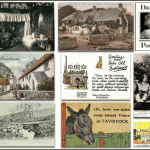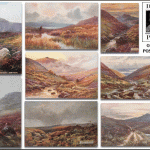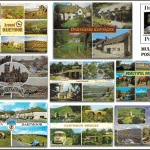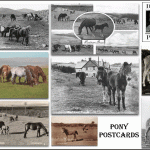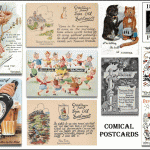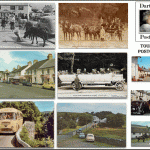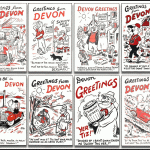
When on holiday most people like to send postcards of places they have visited to their family and friends, either to show where there are or what they have seen, maybe rather cynically even to brag about where they are. Perhaps in this day and age of instant media such as Facebook, Snapchat, Twitter and a host of other such apps the good old fashioned postcards days are numbered. However, visit any Dartmoor gift shop and you will still see racks and racks of scenic postcards, many showing the obligatory Dartmoor pony, slowly spinning around in the breeze. Or even more annoyingly spinning around whilst you are viewing them by someone else on the other side. For a couple of centuries now postcards have provided an income both for the folk who took the original photograph, the publishers and the vendors who also sold postage stamps.
In 1870 the Post Office Act did two things; firstly it banned the sending of indecent or obscene literature (I kid you not, I have seen a few dodgy early postcards) and secondly it introduced the ½d rate for postcards which were simply plain cards with a pre-printed stamp. In most circumstances these cards would be delivered locally on the same day. Then in 1894 the first picture postcards were introduced in the United Kingdom and whereas previously the Post Office had the sole rights permission was granted for other people to publish them. These were smaller than the original postcards and measured 12cm x 8.9cm which allowed space for the address. In 1899 the sizes increased to 13.97cm x 8.9cm but still consisted of a picture on one side with the address on the back. In those days it was not the done thing to write personal messages for all and sundry to see but some people would write around the edge of the front picture nevertheless. Finally in 1902 most postcards were printed with a picture on the front and the back was divided in two by a line down the middle allowing the address to go on the right-hand side and a message on the left. As far as the cost of postage went this remained at ½d price right up until 1918 when it was increased to 1d.
The introduction of the two-sided postcard along with the greater mobility of the population saw a dramatic rise in the popularity of sending postcards. In the case of Dartmoor most of these depicted either early sepia or black and white photographs or oilette pictures (see below). The favourite subjects for these cards were; Dartmoor rustic landscapes, ponies, churches and their interiors, Dartmoor Prison, archaeological subjects, bridges and village street scenes. In the early 1920s one of the main publishers of picture postcards was William Chapman whose business began in Dawlish. In the summer months he would tour around Dartmoor in a pony and trap taking numerous photographs of various aspects of Dartmoor and Dartmoor life. Then in the winter months he would print off the ones he deemed saleable in readiness for selling them to the various shops, post offices, and other retailers in the following Spring. In the early days all of Chapman’s photographs were of the vignette type and later moved over to black and white.
Another popular postcard of the time were those produced by the London firm of Raphael Tuck & Sons, as well as selling the traditional vignette and black and white photographs they introduced oilettes in 1903. These were basically miniature oil paintings done by local artists, some of the early cards had simulated brush strokes whilst others were just smooth surfaces. In the case of Dartmoor the most popular subjects were landscapes, many of which depicted moor folk somewhere in the scene, either at work or going about their everyday business. Amongst the artists whose work appeared on Tuck’s postcards were: G. H. Jenkins jnr., H. B. Wimbush, A. de Breanski jnr. and J. T. Adams. Obviously some clever marketing went on here because along with the normal series of postcards Tuck’s would also re-use the same paintings as greetings postcards. There were birthday cards, Easter cards and Christmas cards along with a few simply saying best wishes from.
Friths were another early publisher of postcards which depicted a variety of Dartmoor’s aspects, In 1860 Francis Frith set himself the goal of photographing every town and village in the United Kingdom. Initially he travelled around the country himself but eventually resorted to hiring local photographers and many of the images they took were published by his postcard company. Many examples of the Frith Comapany’s work can be found on Dartmoor postcards dating from the mid 1800s right up until the company closed in 1971. Today many of his photographs can still be purchased from his archive.
The next notable trend was for colour photographs which again depicted many aspects of Dartmoor and Dartmoor life coming from publishers such as J. Hinde, J. A. Dixon, Jarrold & Son, Judges, Phot precision, Harvey Barton and Forest Publishing to name but a few. It was with colour postcards that the trend of multi-views became popular, these depicted a collage of various aspects of Dartmoor or a series of related subjects such as churches, bridges, ponies, cottages, or villages. There is one modern version of the postcard which thanks to the internet became the fashion a few years ago and this was the ‘virtual postcard’. These can be easily sent from some websites, it’s just a case of choosing a picture and entering the recipients email address and hey presto a postcard land in their in-box as opposed to their postbox. At one time the Dartmoor National Park Authority had such a facility on their website but this has gone in favour of Instagram as have most of the other touristy websites. It seems that the DPNA now provide a DIY version of this as most of the visitor centres have free WiFi access which allows folk to upload their photographs to whichever destination they choose.
But what today can we learn from postcards? Basically they all are a snapshot in time from which many things can be deduced. For instance if you look at the ‘Touristy’ selection below you can see the types of transport visitors were using to get to the moor. You can see the clothing fashions of the day and in some cases what they were doing. With the ‘Pony’ selection it is possible to see how over time the breeds have changed. In the early postcards many of the ponies depicted were of the traditional moorland type whereas some of the modern ones depict Shetland Ponies, something that would rarely be seen in the early 1900s. This goes for the ones that depict sheep and cattle, again one can see the changes that have taken place down through the ages. With buildings such as churches, inns, pubs, cottages, it is possible to see how much or not they have changed, again this applies to some of the old prehistoric ritual monuments such as stone rows and circles. Certainly in the case of the latter these can be very enlightening as much of the landscape in which they stand has changed completely, a prime example of this is Fernworthy Stone Circle. As can be seen below, the early postcards show this standing in a moorland landscape whereas today they are engulfed in trees. The other thing to note is how the exact same photograph has been published in two versions, one in sepia and the other in colour.
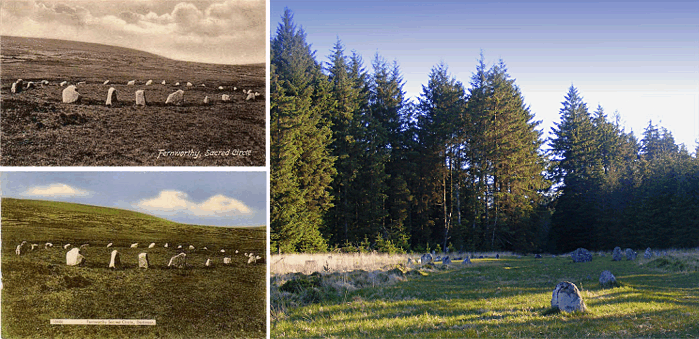
From a historical viewpoint some of the early postcards show landscape features that no longer exist such as bridges, buildings and other structures which can be useful to historians, people researching family histories etc. Whilst on a historical bent another unique aspect of postcards is the one associated with letterboxing, in normal circumstances it is possible to find a letterbox, put its stamp on a self addressed postcard and leave it in the container. The next person to find the letterbox will hopefully pop it in a convenient postbox, not necessarily a local one, and a few days later it gets returned to your address.
Another aspect that can be seen from postcards are social attitudes and beliefs. It is notable how the early postcards depict the famous Dartmoor Piskies in one form or another but today such subjects are nowhere to be seen, its as if their popularity has declined with local belief. Traditional Devonshire foods was another early subject for postcards, Francis frith produced several of these showing such delicacies as jam and cream, junket, goose, tea and scones along with the early kitchens in which they were made.
Another interesting series of postcards were published in the 1950s and 60s by George Stilling, these were two coloured cartoons depicting Devonshire tourists and local villagers. As can be seen below the locals were depicted as yokels all speaking in Devonshire dialect and dressed in smocks, breeches and gaiters. First impressions would be that the artist was deriding the Devonshire folk as country bumpkins who drank copious amounts of cider and’ talked funny’. However, equally as derisive, the tourists are depicted as typical ‘Townies’ who can’t take their scrumpy, are unable to navigate around the county, are unable to drive on the narrow lanes and steep hills and also ‘talk funny’ – not a lot has changed in this case then.
Over the past 100 years by far the most popular Dartmoor postcard subjects are Haytor, the Postbridge Clapper, Dartmoor Prison, Ponies, the Warrenhouse Inn, Widecombe-in-the-Moor, Fingle Bridge, Cranmere Pool and Dartmeet. Most of these are still the most popular visitor locations and subjects of today.
As with any hobby postcard collecting has an official name – Deltiology and according to Wikipedia is the third most popular collecting hobby in the world, next only to coin/bank note collecting and stamp collecting. Popular sources for Deltiologist to acquire their postcards are at antique and collectors fairs, dedicated postcard events and of course on-line. Currently (13/05/2016) there are 2,221 Dartmoor postcards for sale on Ebay alone with asking prices ranging from £32 to 40p for single cards. Tavistock Market often has stalls selling Dartmoor and Devonshire postcards, usually all boxed by subject and quite addictive if you have the time to spare. I have a small collection of early Dartmoor postcards mostly consisting of prehistoric ritual sites, stone crosses, Cranemere Pool, Lydford, and traditional Devonshire meals. The most expensive card in the collection is one published by Chapman which depicts a moorman cutting peat in a turf tie which if I remember correctly cost me around £20 and can be seen by following the ‘peat’ link. I have also a huge box full of what I call run of the mill cards many of which can be seen below.
So next time you visit Dartmoor and send a postcard home to family and friends just think in 100 years time it may be a valuable source of social and historic interest and just maybe worth a quid or two. By doing so you have also contributed to the local economy and, depending what the postcard’s subject is, promoted Dartmoor and maybe inspired other people to visit or perhaps added to some Deltiologists collection.
 Legendary Dartmoor The many aspects past and present of Dartmoor
Legendary Dartmoor The many aspects past and present of Dartmoor

